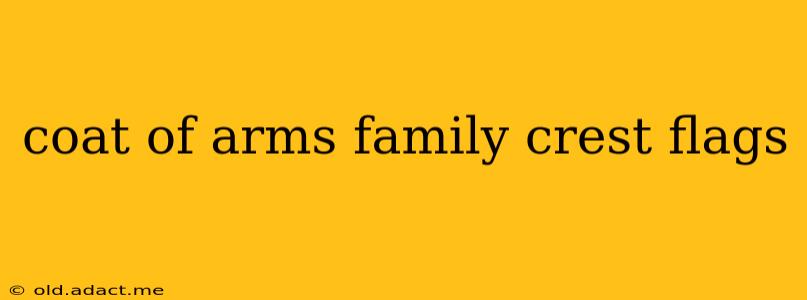For centuries, coats of arms, family crests, and flags have served as powerful symbols of identity, heritage, and lineage. Understanding their distinctions and historical significance offers a fascinating glimpse into the rich tapestry of human history and cultural expression. This comprehensive guide delves into the nuances of these emblems, exploring their origins, design elements, and modern-day interpretations.
What is a Coat of Arms?
A coat of arms is a formal heraldic design, essentially a unique emblem granted to an individual, family, or institution. Unlike a family crest, which is only part of a coat of arms, the coat of arms is the complete heraldic achievement, encompassing several elements:
- The Shield: The central and most important part, bearing the main charges (symbols) and tinctures (colors).
- The Crest: A figure placed above the helmet, often representing a symbolic aspect of the family's history or values. This is what many people commonly refer to as a "family crest," though technically it's only a component.
- The Helmet: Positioned above the shield, its style varies depending on the rank of the bearer.
- The Mantling: A decorative cloth draped behind the helmet, often in contrasting colors.
- The Motto: A short phrase or inscription expressing the family's ideals or aspirations, usually displayed on a scroll below the shield.
- Supporters: Figures (animals, humans, etc.) flanking the shield, further enhancing the heraldic display. These are usually reserved for higher nobility.
What is a Family Crest?
As mentioned, the term "family crest" is often used interchangeably with "coat of arms," leading to confusion. However, a family crest specifically refers to the figure or device placed atop the helmet in a coat of arms. It’s a single element within the larger heraldic design, representing a specific symbol or image related to the family's history or identity. Think of it as one piece of a larger puzzle.
How Do Family Crests and Coats of Arms Differ from Flags?
While coats of arms and family crests represent familial or institutional identity, flags symbolize nations, states, regions, or organizations. Flags are primarily designed for visual display, often featuring simpler designs than coats of arms for better recognition from afar. They utilize bold colors and shapes for immediate impact, unlike the intricate detail sometimes found in heraldic designs. A flag's symbolism may draw inspiration from historical events, natural features, or cultural beliefs, but its purpose differs greatly from that of a personal or family emblem.
What is the difference between a coat of arms and a logo?
A coat of arms is a formalized heraldic design with strict rules and regulations governing its creation and usage, whereas a logo is a graphic design intended for branding and identification. Logos are far more flexible in their style and design, adapting to a company's needs without adhering to the historical precedents and regulations of heraldry.
Can anyone design a coat of arms or family crest?
No. Historically, coats of arms were granted by a sovereign or heraldic authority. While it's now possible to commission a bespoke heraldic design, it's important to understand that these are not “official” grants of arms. They are often created for personal or decorative purposes, and should not be presented as genuine historical coats of arms.
How can I research my family's coat of arms?
Researching your family's heraldic history can be a rewarding but challenging endeavor. Begin by exploring family records, historical documents, and genealogical databases. You may find documented coats of arms, but remember to verify their authenticity through reputable historical sources. Online resources may offer information, but always approach them critically.
Where can I find images of coats of arms and family crests?
Numerous online resources and books showcase examples of coats of arms and crests. However, always exercise caution when using these images, verifying the source and accuracy of the information presented. Remember that many images online are of dubious origin and might not be historically accurate representations.
In conclusion, coats of arms, family crests, and flags, while visually similar at times, serve distinct purposes. Understanding their historical contexts and symbolic meanings allows for a richer appreciation of their significance in shaping identities, both personal and national. Careful research and a critical eye are crucial when navigating the complex world of heraldry and national symbology.
